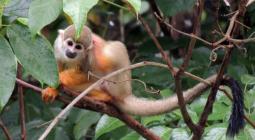'This makes Chinese medicine look bad': TCM supporters condemn illegal wildlife trade

Experts warn the exploitation of endangered animals such as pangolin and tiger is tarnishing the industry
Supporters and practitioners of traditional Chinese medicine have warned that the discipline is threatened by those who continue to trade in endangered animals.
The small segment of the TCM community that insists on using endangered animal parts in the pharmaceutical side of TCM, ignoring welfare considerations and the idea of respecting biodiversity, could destroy its reputation for good, they argue.
“The balance with nature is a key point [of TCM], and the use of [endangered] animals is against nature,” Dr Lixing Lao, president of the Virginia University of Integrative Medicine, told the Guardian.
“Even in the principles of TCM practice, this is not good,” Lao said, referring to Tang dynasty experts 1,500 years ago who believed 100% of TCM could be derived from plants.
TCM encompasses many things – acupuncture therapies, breathing and physical exercise, eating habits related to particular conditions of the body and a variety of views about how to strike balance within the body, alongside medicinal TCM drugs.
For Lao and others, the path of reform is to abandon the use of parts derived from endangered species such as pangolins, tigers, leopards and rhinos.

The $74bn (£60bn) wildlife trade in China, pointed to as a likely source of Covid-19, has been largely perpetuated by superstition and confusion about the benefits of animal parts.
Until the recent nationwide pause on the wildlife trade, China’s state forestry and grassland administration provided permits to TCM pharmaceutical companies to use animal parts from previous stockpiles or “farmed” wildlife.
But poaching and the illegal trafficking of parts and live animals from protected species across the globe has continued. The parts are sold to companies making either TCM pharmaceuticals – dried and baked pangolin scales, for example, are ground into powder for several treatments – or for products such as tiger and leopard bone wine, advertised as having “TCM qualities”.
“This is not as much a Chinese medicine practitioner issue, it is more the industry, the people who make money,” Lao said. “This makes Chinese medicine look bad. They use our TCM name for their own purpose but we’re innocent.”
Rhino horn and tiger bone were removed from the Chinese Pharmacopoeia, the official listing of what is allowed in TCM, in the 1980s. Wildlife conservation organisation Traffic told the Guardian that it has seen positive direction from within the TCM community in China in recent years to move away from the use of threatened species. Richard Thomas, communications director at Traffic, said: “The issue is very much within the TCM consciousness.”

China’s government and leaders, including President Xi Jinping, have long lauded the benefits of TCM medicines. Xi is firmly behind the idea of combining traditional Chinese and western medicine, and has encouraged the acceleration of research on TCM drugs.
TCM experts such as Lao believe medicinal cures should be used only when absolutely necessary and not overprescribed in the way western pharmaceuticals often are, instead favouring deeper preventive practices to reduce the need for medicine in the first place.
But support for TCM, which was formally approved into the global compendium of medical practices by the World Health Organization last year, may dissipate if the issues at the heart of the wildlife trade – which is linked in many people’s minds to the Covid-19 outbreak and decimation of endangered species – are not addressed.
Big Business
For Xi and much of the country’s leadership, promoting TCM is one of several ways of raising millions out of poverty. By the end of 2020, China’s state council expects the total value of the country’s TCM industry to reach about $420bn, according to a white paper it released four years ago. In China’s TCM capital of Bozhou, Anhui province, the industry is estimated to be worth 109bn yuan ($15bn).
The report also indicated that there were 900 million TCM practitioners in 183 countries, and growing. TCM hospitals and clinics in China recorded a billion visits in 2017 and that number is increasing by about 6% a year.
Separately, a 2017 report from the Chinese Academy of Engineering put the total value of the wildlife industry specifically breeding parts for TCM at 50bn yuan, or about $7bn.

That figure does not take into account the illegal trade in live animals, whole dead animals and animal parts. That number is likely to be many times higher, judging by seizures of animal parts such as pangolin scales, rhino horn and tiger bone.
In February, China’s National People’s Congress put a full ban on any trade in terrestrial wildlife until the country’s Wildlife Protection Law and follow-on regulations around the industry can be fully updated – though the main focus will likely be on bushmeat, with little action expected on products used for TCM and fur or leather.
Moves are also afoot globally to stop all use of endangered wildlife in traditional medicine. Three Chinese NGOs and two global organisations recently proposed that all members of the International Union for the Conservation of Nature (IUCN) support a halt to the use of threatened species in traditional medicine.
The proposal was listed by the IUCN and will go before members for approval or debate in January next year. No timeline for members to adopt any of the language will be available until the text is agreed upon.
“We support the sustainable development of traditional medicine,” Linda Wong, deputy secretary general of the China Biodiversity Conservation and Green Development Foundation, one of the NGOs involved in bringing the proposal forward, told the Guardian. “We strongly disagree with the use of endangered wildlife in traditional medicine, which drives species like the pangolin to extinction,” she said, adding that of 128 motions currently under consideration by the IUCN this year, it is the “most controversial”.
“Recent moves to reopen trade in these products appear very much business-interest driven rather than medicinal-sector driven,” Richard Thomas told the Guardian.
The confusion and mixed signals over what is legal and what is illegal only adds to potential loopholes, many conservation activists claim.

Debbie Banks, tigers and wildlife crime campaign leader at the UK-based Environmental Investigation Agency, said there are still many issues to work out in the text of the IUCN motion, particularly related to “sustainable use” of wildlife and adopting what is known as the FairWild standard for sourcing wild plants and applying it to wildlife.
“There is a risk that advocates for captive breeding of tigers [for example] will use this language to argue that the ‘harvest’ of tigers bred in captivity is sustainable, without taking into account that the trade in captive-bred specimens sustains demand for wild specimens, particularly given consumer preference for wild,” Banks said.
Banks adds that standards meant for plant species can’t simply be applied to the harvesting of wild animal products and reference in the motion should be explicitly stated as applying to plants only.
“We’ve been hoping that lawmakers extend provisions to Chinese medicine under the reforms to the Wildlife Protection Law, as academics and NGOs in China have been proposing,” said Aron White, China specialist at the Environmental Investigation Agency.
“The problem isn’t Chinese medicine per se, it’s the ingredients that are still used that are made from threatened wildlife which could be replaced by herbal or artificial alternatives, as many practitioners already do,” White said.
Bear bile and Covid-19
Throughout the Covid-19 outbreak, China’s leaders and state-run media have supported the TCM industry, concentrating largely on the benefits of TCM pharmaceuticals as a pillar industry. TCM doctor Zhang Boli, who set up a makeshift hospital where none of the 564 carriers of Covid-19 that he treated with TCM drugs turned into critical cases, was hailed as a success, with state-run media and government officials showering him with praise.
But a recent report in the journal Nature indicated growing calls outside of China for more rigorous clinical trials of TCM products, especially those promoted abroad as Covid-19 treatments. These are often being sent with aid shipments of personal protective equipment.
Outside China, the use of bile extracted from the gall bladders of captive Asiatic black bears as one ingredient in TCM drugs listed by the government as treatment for severe and critical coronavirus cases has been strongly criticised by wildlife groups.

“It really pains me to see that TCM is now using bear bile to treat Covid-19 and the amount used is so tiny,” Grace Gabriel, Asia director for the International Fund for Animal Welfare (IFAW), told the Guardian.
“Why, why do you want to destroy your good name and associate with that?” Gabriel said. “The only conclusion that I can come to, is that the wildlife farming industry [in China] has hijacked TCM’s name.”
Originally from China, Gabriel grew up during the Cultural Revolution and was often able to get medical assistance only from TCM doctors and counts herself as a believer in TCM’s benefits.
“As a Chinese [person] I really respect TCM, and one of the underlying principles is to achieve balance within one’s own body as well as with the outside world,” she said.
China already has alternatives to bear bile that can be used as a substitute in TCM drugs, she said, but the captive breeding industry is so strong they don’t want to see those alternatives promoted.
“The one thing that is missing is education,” Lao said. “We need to educate the public that Chinese medicine emphasises the balance between humans and nature, so we have to respect nature.”
-
Additional reporting by Jonathan Zhong
26 May 2020
The Guardian




